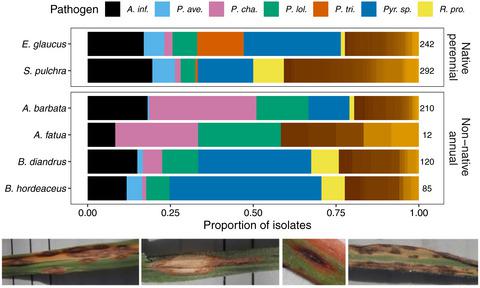Our official English website, www.x-mol.net, welcomes your
feedback! (Note: you will need to create a separate account there.)
Native perennial and non‐native annual grasses shape pathogen community composition and disease severity in a California grassland
Journal of Ecology ( IF 5.3 ) Pub Date : 2020-10-08 , DOI: 10.1111/1365-2745.13515 Amy E Kendig 1 , Erin R Spear 2 , S Caroline Daws 3 , S Luke Flory 1 , Erin A Mordecai 3
中文翻译:

本地多年生和非本地一年生草类影响加州草原的病原体群落组成和疾病严重程度
更新日期:2020-10-08
Journal of Ecology ( IF 5.3 ) Pub Date : 2020-10-08 , DOI: 10.1111/1365-2745.13515 Amy E Kendig 1 , Erin R Spear 2 , S Caroline Daws 3 , S Luke Flory 1 , Erin A Mordecai 3
Affiliation

|
- The densities of highly competent plant hosts (i.e. those that are susceptible to and successfully transmit a pathogen) may shape pathogen community composition and disease severity, altering disease risk and impacts. Life history and evolutionary history can influence host competence; longer lived species tend to be better defended than shorter lived species and pathogens adapt to infect species with which they have longer evolutionary histories. It is unclear, however, how the densities of species that differ in competence due to life and evolutionary histories affect plant pathogen community composition and disease severity.
- We examined foliar fungal pathogens of two host groups in a California grassland: native perennial and non‐native annual grasses. We first characterized pathogen community composition and disease severity of the two host groups to approximate differences in competence. We then used observational and manipulated gradients of native perennial and non‐native annual grass densities to assess the effects of each host group on pathogen community composition and disease severity in 1‐m2 plots.
- Native perennial and non‐native annual grasses hosted distinct pathogen communities but shared generalist pathogens. Native perennial grasses experienced 26% higher disease severity than non‐native annuals. Only the observational gradient of native perennial grass density affected disease severity; there were no other significant relationships between host group density and either disease severity or pathogen community composition.
- Synthesis. The life and evolutionary histories of grasses likely influence their competence for different pathogen species, exemplified by distinct pathogen communities and differences in disease severity. However, there was limited evidence that the density of either host group affected pathogen community composition or disease severity. Therefore, competence for different pathogens likely shapes pathogen community composition and disease severity but may not interact with host density to alter disease risk and impacts at small scales.
中文翻译:

本地多年生和非本地一年生草类影响加州草原的病原体群落组成和疾病严重程度
高能力植物宿主(即那些容易感染并成功传播病原体的植物宿主)的密度可能会影响病原体群落组成和疾病严重程度,从而改变疾病风险和影响。生活史和进化史会影响宿主的能力;寿命较长的物种往往比寿命较短的物种受到更好的防御,并且病原体适应感染具有较长进化历史的物种。然而,尚不清楚由于生命和进化历史而能力不同的物种密度如何影响植物病原体群落组成和疾病严重程度。
我们检查了加州草原上两个寄主群体的叶面真菌病原体:本地多年生草和非本地一年生草。我们首先表征了两个宿主群体的病原体群落组成和疾病严重程度,以估计能力差异。然后,我们使用本地多年生草和非本地一年生草密度的观察和操纵梯度来评估每个宿主群体对 1-m 2地块中病原体群落组成和疾病严重程度的影响。
本地多年生草本植物和非本地一年生草本植物拥有不同的病原体群落,但具有共同的通用病原体。本地多年生草本植物的疾病严重程度比非本地一年生草本植物高 26%。只有本地多年生草密度的观测梯度影响疾病的严重程度;宿主群体密度与疾病严重程度或病原体群落组成之间没有其他显着关系。
合成。草类的生命和进化历史可能会影响它们对不同病原体物种的能力,例如不同的病原体群落和疾病严重程度的差异。然而,有限的证据表明任一宿主群体的密度影响病原体群落组成或疾病严重程度。因此,对不同病原体的能力可能会影响病原体群落的组成和疾病的严重程度,但可能不会与宿主密度相互作用,从而在小范围内改变疾病风险和影响。











































 京公网安备 11010802027423号
京公网安备 11010802027423号